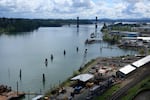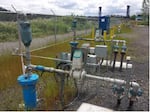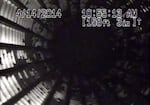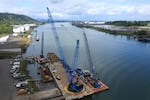Gas company NW Natural spent $21 million building a state-of-the art groundwater treatment system that would stop toxic pollution from flowing off its industrial site into the Willamette River.
It's a celebrated example of "early action" taken voluntarily by some of the companies responsible for cleaning up contamination at the Portland Harbor Superfund Site.

More than a hundred parties share responsibility for cleaning up the highly polluted 10-mile stretch of the Willamette River known as the Portland Harbor Superfund Site.
Cassandra Profita/OPB / EarthFix
But now, the companies downriver from NW Natural say that fancy new system is ineffective and needs to be replaced. They say not only is toxic pollution still flowing off the site through groundwater, but there's also evidence that oily black globs of tar pollution are moving toward the river underground.

Dozens of these wells pump contaminated groundwater on the NW Natural Property south of the St. Johns Bridge and treat it before releasing it into the river.
Courtesy of NW Natural
They've sent letters and a video to state and federal regulators flagging ongoing pollution problems at the NW Natural site, and they've asked the Environmental Protection Agency to make sure they don't get stuck cleaning up the mess.
The dispute is likely one of many that will need to be settled before the slow-moving cleanup of the Portland Harbor Superfund Site can officially begin.
More than 10 miles of Portland's Willamette River from the Broadway Bridge to the Columbia Slough is highly contaminated with more than a century of industrial pollution. The area has been designated a Superfund site since 2000. Last year the EPA finally finished its cleanup plan, but the actual cleanup still hasn't started.
The process has entered a new phase, however, where dozens of parties responsible for the pollution in the river will privately sort out who is going to pay for what portion of the $1 billion cleanup.
Who's Going To Stop The Oily Tar Globs?

A video of a water well inspection shows black globs of oil moving through the water on NW Natural's Gasco site.
NW Natural's riverfront property south of Portland's St. Johns Bridge is where Portland Gas & Coke Co., the predecessor to NW Natural, once operated a manufactured gas plant called Gasco.
The plant heated oil to make gas, dumping some of the tar and other toxic byproducts into the river while stockpiling the rest on land. The extensive pollution it left behind means rain falling on the site and water moving deep underground absorb a cocktail of contaminants on their way to the river.
The company's current defense against that stream of pollution lies on a long, bare stretch of the riverbank where dozens of blue and yellow pipes jut out of the ground. They're part of an elaborate treatment system designed to collect contaminated water flowing underground and clean it before it goes into the river.
In an interview with OPB in 2016, shortly after the system was installed, Bob Wyatt, director of the legacy environmental program for NW Natural, said the goal was to put up a barrier between the river and the contamination on land.
The water pumps were "optimally placed to assure we have 100 percent groundwater capture, so that nothing in the uplands that's contaminated reaches the river anymore," he said.
State regulators now say the system is working to prevent the most polluted groundwater from entering the river. However, they say, the system doesn't intercept contaminated "shallow" groundwater, which is still flowing directly into the river. It also doesn't stop the layer of black, oily tar residue that sinks to the bottom of the "deep" groundwater.
Neighbors Raise Concerns
A group of companies that own property downstream from NW Natural say that's not good enough.
“There are studies and data showing there is still contaminants migrating into the river from the Gasco site,” said Paul Vogel, a spokesman for a collection of companies on the river that includes BP, ExxonMobil and Toyota. They call themselves the River Mile 4-7 Group.
"There are videos showing this tar substance moving through wells on the site," Vogel said. "You can see it. You can see it moving. ... This doesn’t go back to the last century. This is ongoing. Happening right now.”
The group has documented pollutants from the Gasco site downstream near their properties. The main pollutants coming from the site are polycyclic aromatic hydrocarbons or PAHs. The group did their own analysis to “fingerprint” these pollutants in the river – proving they could only have come from NW Natural’s Gasco site.
"While the River Mile 4-7 parties are willing to address any contaminants that they are shown to be responsible for, we believe it is more appropriate for the EPA to require the clearly responsible party to address the problem it created," the group wrote in a letter to the Environmental Protection Agency, which is in charge of the Superfund cleanup.
Then, they asked the EPA to expand the NW Natural cleanup site area to include additional river miles downstream. In fact, they noted, the EPA had called for that kind of expansion at one point, but then reversed its position.
Vogel said the threat of ongoing pollution from the NW Natural site – from groundwater, stormwater and oily black globs – needs to stop before the billion-dollar Superfund cleanup begins.
“Otherwise it’s a bit like mopping the floor with muddy boots," he said. "You’re threatening to recontaminate a stretch of the Willamette River that you’ve just cleaned up.”

Hundreds of parties share responsibility for cleaning up the Portland Harbor Superfund Site.
Cassandra Profita/OPB
Plans To Stop Ongoing Pollution
Dana Bayuk is with the Oregon Department of Environmental Quality, the state agency charged with making sure pollution on land doesn't recontaminate the river after the Superfund cleanup.
He says the River Mile 4-7 Group is correct on one count: Toxic pollution is still flowing into the river from NW Natural's Gasco site.
But he says there’s no evidence the oily black globs in the video are moving into the river. As far as he can tell, they’re still just moving underground. It's one of the consequences of all the tar the Gasco operation left behind.
In 2005, NW Natural removed a giant tarball – 15,000 cubic yards of tar – from the river next to the site. But that's just a fraction of what's on the site.
"Much of the legacy contamination is still there," Bayuk said. “There probably is tons of tar in the fill at that site."
The tar is filled with cancer-causing waste. And there are many ways for those pollutants to move around – including in the form of oily black globs.
Bayuk and NW Natural say before the Superfund cleanup is finished, they plan to stop all the layers of liquid pollution on the site from entering the river – from shallow and deep groundwater to the oily globs.
"It's complicated, and it can take time," Bayuk said. “The problem is recognized, and from an overall standpoint it’s being addressed.”
NW Natural spokeswoman Melissa Moore said her company will continue to work on its portion of the cleanup as it is outlined in the EPA's official cleanup plan "while some other parties seem more interested in getting a different solution, which will simply delay the cleanup."
Moore said her company is actually ahead of other companies that haven't taken any early cleanup action.
“We’re ahead of everyone else because at least we’ve started,” she said. “We’re a party that’s taking responsibility.”
'A Very Messy Process'
So, why do the companies downstream care so much? Probably because we’ve officially entered a new phase of the Portland Harbor Superfund Cleanup called "allocation."
“It’s a very messy process," said Travis Williams, director of the environmental group Willamette Riverkeeper. "You really don’t hear that much about it, typically.”
Most Superfund sites only involve a few polluters, Williams said, but at Portland Harbor more than a hundred parties share responsibility for the cleanup.
Exactly who is responsible for what? That is what's currently being determined in the allocation process.
“It’s a big, complicated negotiation behind closed doors," Williams said. "That’s just the way it is under the law. We don’t have any real insight into what’s happening there.”
Williams said it makes sense for the River Mile 4-7 Group to make sure they don’t spend any more than they have to cleaning up pollution that isn't theirs.
Over the next eight months, dozens of the parties responsible for cleaning up Portland Harbor will be sorting through their disputes. Federal regulators are expecting a road map of who is cleaning up what by the end of the year.
